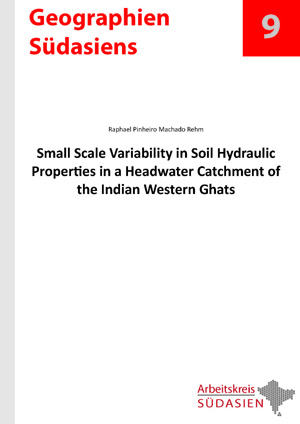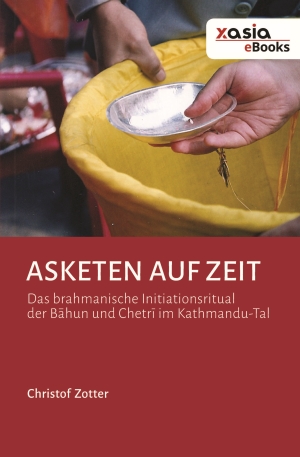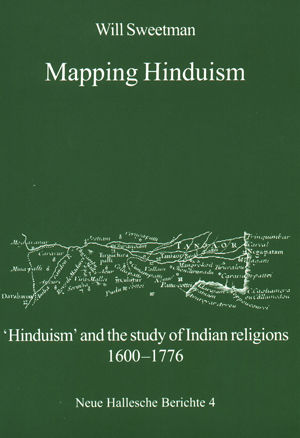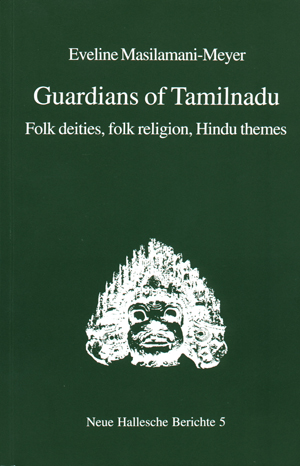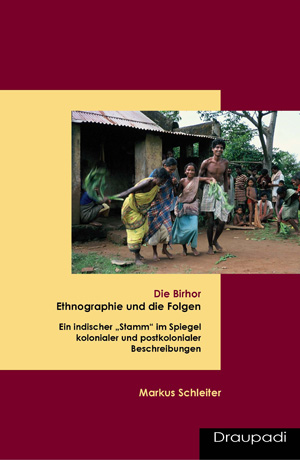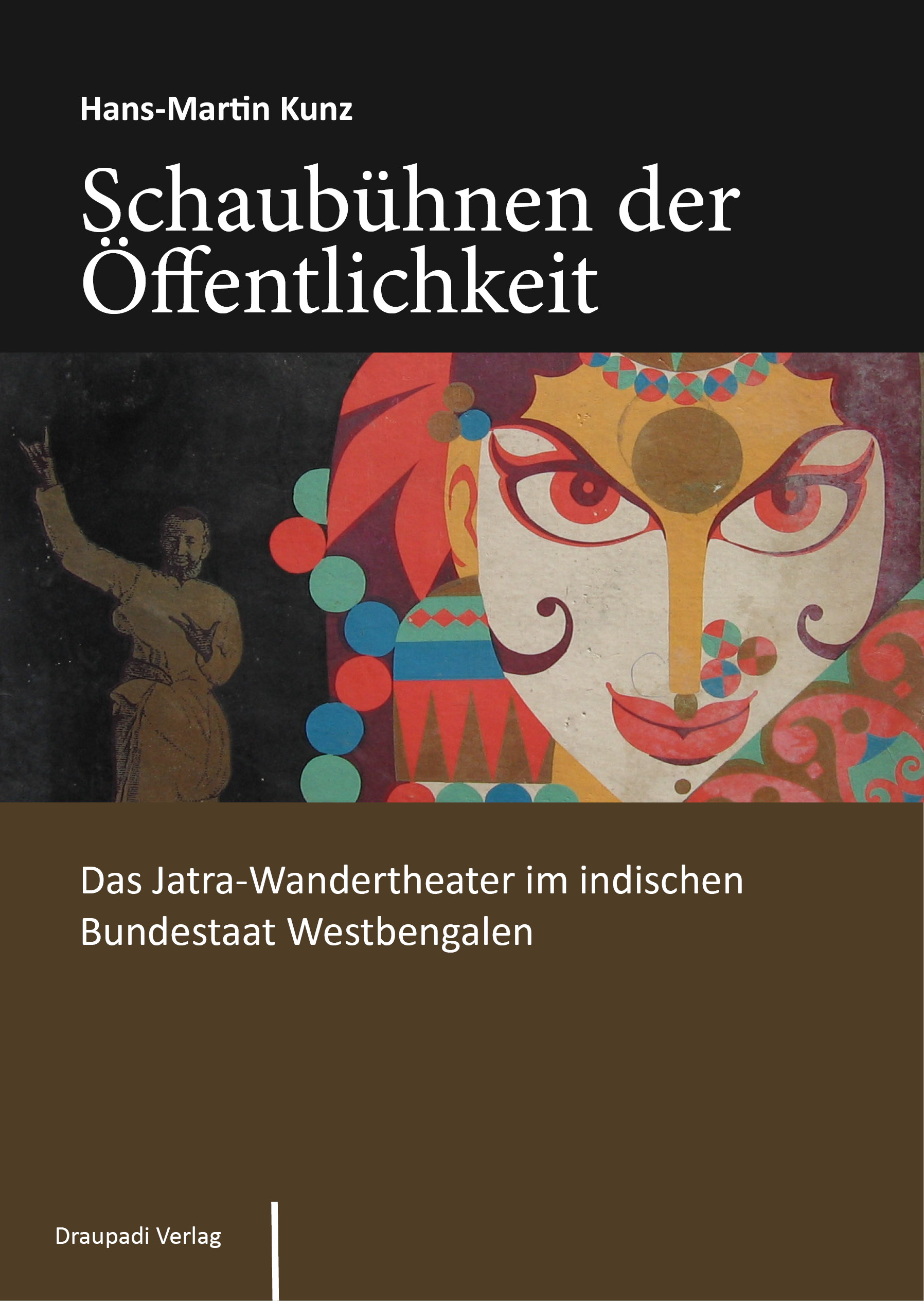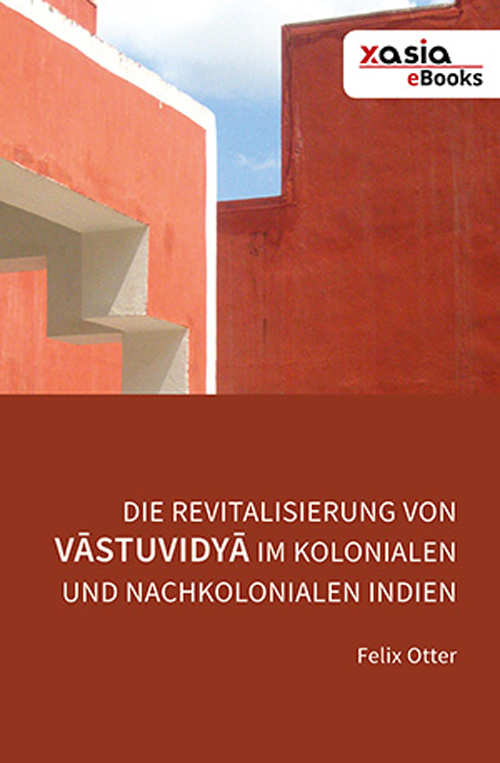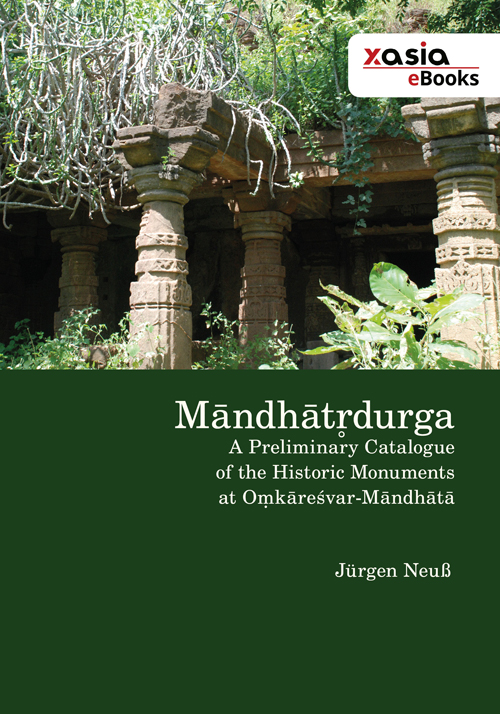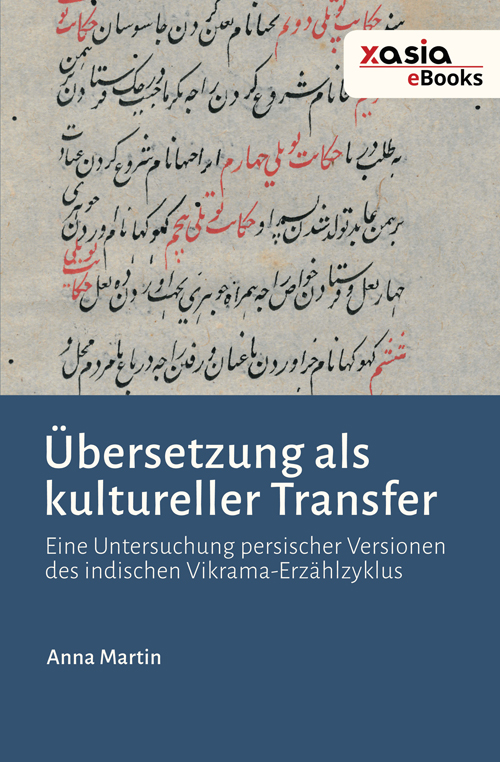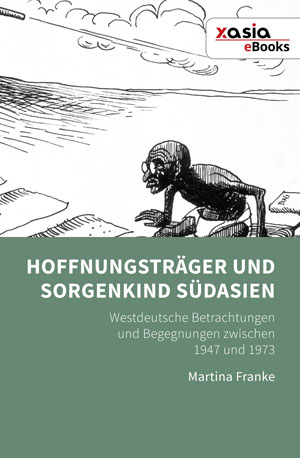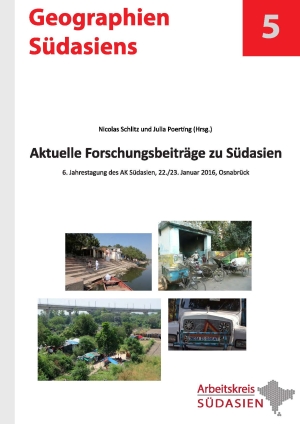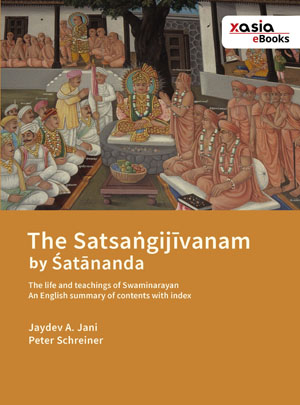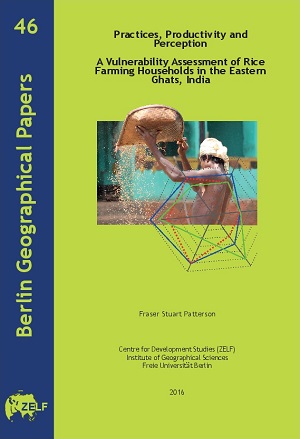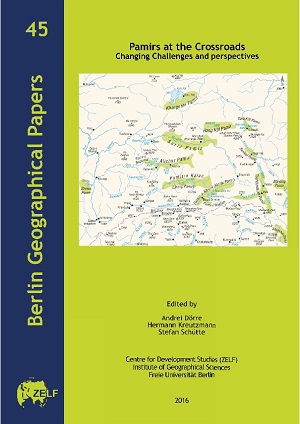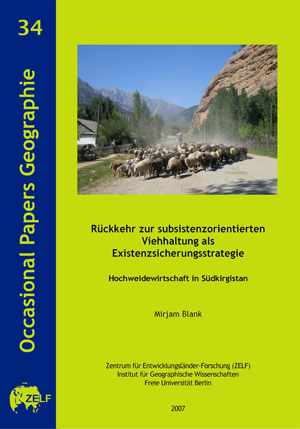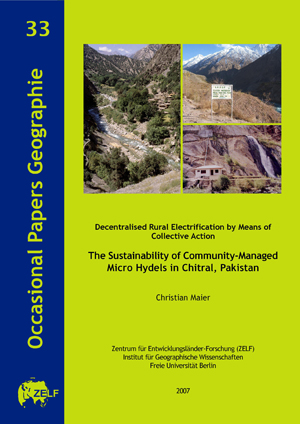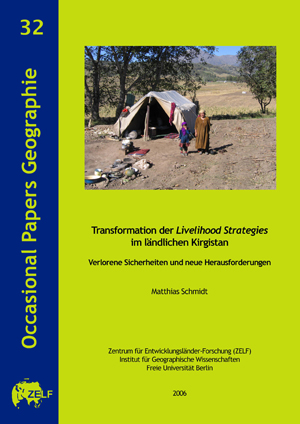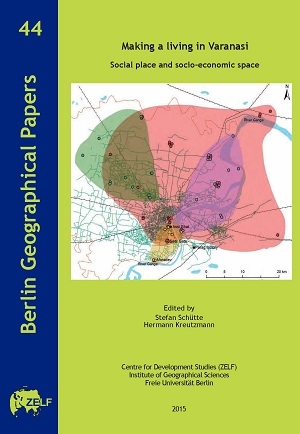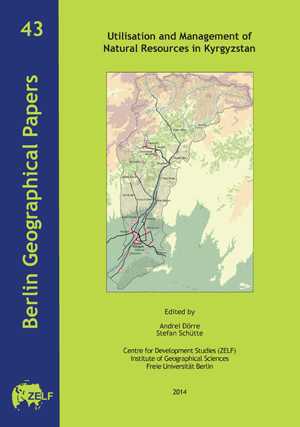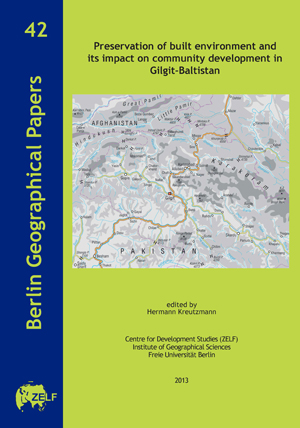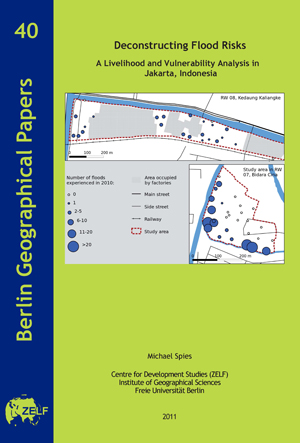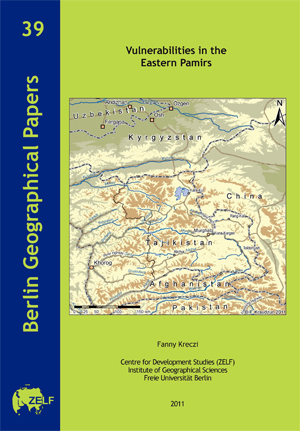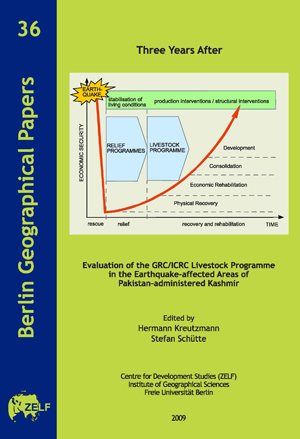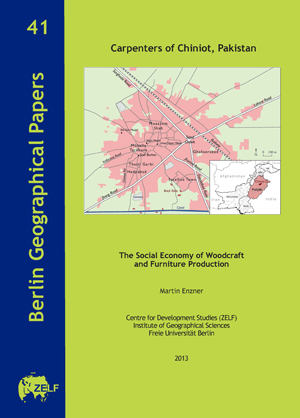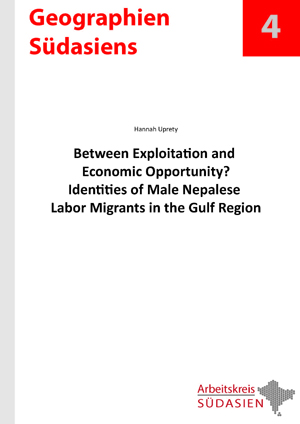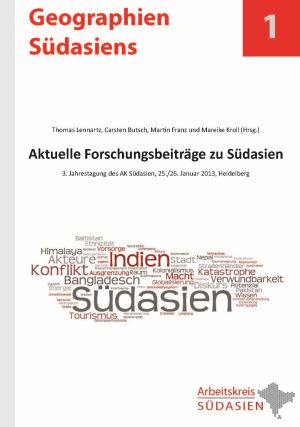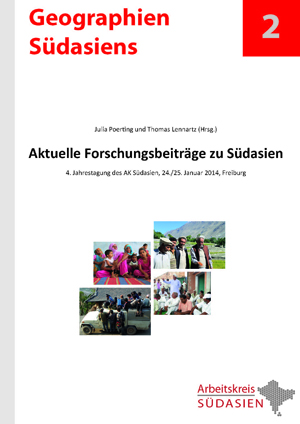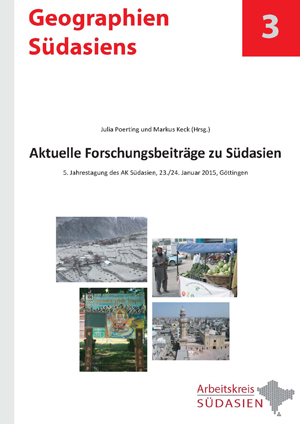Books
Small scale variability in soil hydraulic properties in a headwater catchment of the Indian Western Ghats
The Indian West Ghats are located in the monsoon climate with rainfalls up to over 3000 mm a year. Since the mountain chain is the source of almost all major Indian rivers, the characteristics of the headwater catchment areas are of great importance for the water balance of the entire Indian sub-continent. However, due to its proximity to the agglomeration areas of Mumbai and Pune, the previously rural Pune district in Maharashtra is facing strong demographic and economic growth and is thus increasingly affected by land use change. While these changes can be recognized from satellite data, changes in soil properties are rare avilable. Water affect a variety of physical, chemical and biological processes and by that almost every aspect of soil development and soil behavior. Conversely, the characteristics of soils for hydrological variables, such as the storage and provision of plant-available water, are crucial. In order to understand changes in the hydrology of a region, detailed knowledge of the effects of land use change on soil properties is required. This work should help to understand the characteristic of tropical soil formations in the northern Western Ghats and to show possible effects of different land uses on soil quality with a special focus on hydraulic properties.
HerStory. Historical Scholarship between South Asia and Europe: Festschrift in Honour of Gita Dharampal-Frick
This Festschrift in honour of Professor Dr. Gita Dharampal-Frick assembles a number of innovative contributions by friends, colleagues, and former students to the multiple research areas in the field of history of South Asia that Gita Dharampal-Frick has enriched over the last decades. The essays included in this volume address a broad number of topics and periods, ranging from transcultural encounters between South Asia and Europe, reassessments of colonial discourses and their legacies, novel approaches to the maritime history of the Indian Ocean, and to perspectives on M.K. Gandhi.
Asketen auf Zeit: Das brahmanische Initiationsritual der Bāhun und Chetrī im Kathmandu-Tal
After its integration into the series of life-cycle rituals (saṃskāra) in the first millennium BC, the Brahmanical initiation (upanayana) underwent continual revision and reinterpretation. Today it is performed during a ritual complex called vratabandha, in which it is conducted together with three other saṃskāras, the whole set being embedded in a preliminary and framing ritual.
For the present volume, a combination of textual studies and fieldwork was employed to examine the principles by which a particular Vedic school (the White Yajurveda) and a concrete context (the vratabandha of Nepalese Bāhuns and Chetrīs) combines and adapts elements of different types of ritual (saṃskāra, pūjā, homa, etc.) in order to accommodate itself to changing times and circumstances.
The detailed formal analysis provides a key to interpreting the meaning of the whole complex of acts that constitute a vratabandha, in which the initiate temporarily becomes an ascetic in order to be initiated into his future householder role as a ritual practitioner.
Book reviews
Review of Christof Zotter, Asketen auf Zeit: Das brahmanische Initiationsritual der Bāhun und Chetrī im Kathmandu-Tal. Heidelberg: CrossAsia-eBooks, 2018. Reviewd by Andrea Wollein (University of Toronto) in: International Journal of Hindu Studies 26 (2022).
"Arier" und "Draviden"
Die Frage nach der Geschichte beinhaltete zu allen Zeiten auch die Frage nach der eigenen Identität. Während der britischen Kolonialherrschaft im 19. Jahrhundert begründeten westliche Indologen und christliche Missionare unter Beteiligung Gelehrter der traditionellen einheimischen Wissenssysteme eine südasiatische Geschichtsschreibung, in der die Südasiaten als die Nachkommen unterschiedlicher Völker (insbesondere Arier und Draviden) betrachtet wurden. Diese orientalistischen Geschichtstheorien über Ereignisse, die tausende Jahre zurücklagen, fanden unter unterschiedlichen Vorzeichen Eingang in den politischen Diskurs, und in der Folgezeit wurden diese Projektionen in hohem Maße Bestandteil des Selbstverständnisses verschiedenster politischer Bewegungen und Parteien moderner südasiatischer Staaten. Heute mündet in Südasien fast jede Diskussion über die Vor- und Frühgeschichte beinahe automatisch in eine Debatte um soziale und politische Machtinteressen.
In jüngster Zeit sind es vor allem sogenannte hindu-nationalistische Kreise, die ihre politische Legitimation aus der Vorgeschichte zu ziehen versuchen. Der vorliegende Band leistet damit auch einen wichtigen Beitrag zur Aufhellung der geistigen Hintergründe des im deutschsprachigen Raum immer noch wenig verstandenen Phänomens des Hindu-Nationalismus.
N.B.: Der Beitrag von Edwin Bryant "Disput um die Vergangenheit" kann aus urheberrechtlichen Gründen nicht online veröffentlicht werden.
Westliche Formen des Hinduismus in Deutschland: Eine Übersicht
Der vorliegende Band gibt eine problemorientierte, interdisziplinär angelegte Übersicht über westliche Formen des Hinduismus im deutschsprachigen Raum. Im Zentrum steht dabei die Frage, wie hinduistische Traditionen im kulturellen Kontext Europas adaptiert und reinterpretiert werden und welche Interdependenzen sich zu zeitgenössischen religiösen Bewegungen in Südasien feststellen lassen. Damit soll zugleich ein Beitrag zur konzeptionellen Durchdringung dieses Themenfeldes aus religionswissenschaftlicher Perspektive geleistet werden. Wichtige Gruppierungen, wie Hare Krishna (ISKCON), Transzendentale Meditation, Osho-Bewegung, Brahma Kumaris, Sai Baba, Thakar Singh werden einzeln besprochen und analysiert.
N.B.: Von diesem Sammelband können aus urheberrechtlichen Gründen nur die Beiträge auf CrossAsia-eBooks im Open Access veröffentlicht werden, bei denen die Autorinnen und Autoren ihre Zustimmung erteilt haben.
Mapping Hinduism: "Hinduism" and the study of Indian religions, 1600-1776
The process by which Hinduism came to be constituted as an object of European study is often taken to be the most egregious example of the invention of a religion through the reification of disparate traditions of belief and practice an the projection of theological preconceptions or imperial ambitions. In this work Will Sweetman offers both a theoretical reconsideration of the status of the term Hinduism and an alternative historical account of its emergence in the eighteenth century based on consideration of early Dutch, English, French and German sources, demonstrating that its scope owes more to Indian ideas of religious affiliation as the time of its emergence more to the evolving modern concept of India as a geographical entity than either does to theological preconceptions or imperial ambitions.
Guardians of Tamilnadu: Folk deities, folk religion, Hindu themes
The gods and goddesses that populate the Tamil villages and countryside are rarely called Śiva, Viṣṇu or Pārvāti and yet, they are understood to be forms or aspects of these pan-Hindu deities. Similarly, the ritual performed for the folk deities show traits antagonistic to Brahmanical values and yet, we find in them symbols and myths common to the “high” Sanscritic tradition. In the present work the author traces patterns and structures that help the reader understand the salient features of Tamil folk Hinduism and its differences to and similarities with the “high” tradition.
The book has chapters on the arrangement of the folk deities in the temple, the deities’ place in the ordered and wild space, their relationship with the pan-Hindu gods and goddesses and chapters on how the devotees connect to the folk deities through myths, rituals and worship. The great diversity and richness of the Indian folk religion and the ever greater assimilation of folk cults into the “high” tradition are topics that need to be explored in depth. The present book is a contribution towards this goal.
Die Birhor - Ethnographie und die Folgen: Ein indischer "Stamm" im Spiegel kolonialer und postkolonialer Beschreibungen
Die Birhor sind eine indische ‚Stammesgruppe’. Bekannt sind die Birhor als Spezialisten für Seilherstellung, Affenjagd, Heilkräuter und andere Waldprodukte. In diesem Buch untersucht der Autor die ethnographischen Darstellungen dieser Gruppe über Ansätze der Postcolonial Studies und zeigt dabei Widersprüche, aber auch erstaunliche Gemeinsamkeiten von den ersten kolonialen Berichten seit 1865 bis hin zu den neuesten Ethnographien. Anhand einer eigenen einjährigen „Teilnehmenden Beobachtung“ in deren Siedlungen deckt der Autor auf, dass diese Beschreibungen der Birhor – unter anderem als „unschuldige“ und „fröhliche“ „Jäger und Sammler“ – erhebliche ambivalente Konsequenzen für diese selbst haben. Diese Auswirkungen stehen in engem Zusammenhang mit der staatlichen Entwicklungsarbeit Indiens und umfassen Todesfälle durch Malaria.
Schaubühnen der Öffentlichkeit: Das Jatra-Wandertheater in Westbengalen (Indien)
Jatra ist eine im indischen Bundesstaat Westbengalen populäre Wandertheaterform, die sich im Laufe des 19. und 20. Jahrhunderts vom Volkstheater zu einer bedeutenden Kulturindustrie gewandelt hat und mit seinen melodramatischen, aber oft auch politischen Stücken jährlich mehrere zehn Millionen Menschen auf dem bengalischen und Land und in den Kleinstädten erreicht. Die Dissertation „Schaubühnen der Öffentlichkeit. Das Jatra-Wandertheater in Westbengalen (Indien)“ von Hans Martin Kunz analysiert die von Kalkutta ausgehenden historischen Entwicklungen sowie die aktuellen Modernisierungsstrategien der Akteure dieses tourenden Musicalspektakels und legt dar, dass das Jatra-Theater entgegen seiner üblichen Kategorisierung nicht als Volkstheater, sondern als Massenmedium betrachtet werden muss und seine Rolle zentral für das Verständnis der westbengalischen Öffentlichkeit bzw. public sphere ist.
Die Revitalisierung von Vāstuvidyā im kolonialen und nachkolonialen Indien
Vāstuvidyā, the old Indian esoteric lore of building a house, has been the object of several attempts at revitalisation since the first half of the 20th century. This book examines these attempts in the context of ideological and historical developments with the methods of textual analysis. The relationship between the revived version(s) of Vāstuvidyā with the precolonial formulations of the lore, the relevance of the apologetic discourse of the indigenous sciences for the revitalisation of Vāstuvidyā, and the discourse strategies employed in colonial and post-colonial Vāstu literature are the central themes of the book.
Book Reviews
Review of Felix Otter: Revitalisierung von Vāstuvidyā im kolonialen und nachkolonialen Indien. Heidelberg: CrossAsia-eBooks, 2016. Reviewed by Simon Cubelic for H-SOZ-Kult, 06.07.2018.
Sreeramula Rajeswara Sarma: The Growing Influence of "Vāstuśāstra" in India. Review of: Felix Otter: Revitalisierung von Vāstuvidyā im kolonialen und nachkolonialen Indien. Heidelberg: CrossAsia-eBooks, 2016. In: Orientalistische Literaturzeitung 115 (2), 2020: 97-102.
Māndhātr̥durga: A Preliminary Catalogue of the Historic Monuments at Oṃkāreśvar-Māndhātā
In Māndhātr̥durga – A Preliminary Catalogue of the Historic Monuments at Oṃkāreśvar–Māndhātā Jürgen Neuß offers for the first time a comprehensive survey of the extant historic remains at Oṃkāreśvar-Māndhātā, the most important place of pilgrimage in the Narmadā valley. Although the place has been known as an archaeological site since the middle of the nineteenth century, it has till date been overlooked that the remains are much more extensive and coherent than the rarely published archaeological notes, that deal with only a few monuments, suggest. This book provides a long overdue survey of the whole area which in essence represents a conglomeration of three historic settlements. At the center lies a thoroughly structured fortification, Māndhātr̥durga, which represents the only preserved fortified city of the Paramāras of Dhāra in the Narmadā valley presently known to us.
Übersetzung als kultureller Transfer: Eine Untersuchung persischer Versionen des indischen Vikrama-Erzählzyklus
The Indian king Vikrama embodies the ideal type of a just and generous ruler. We find tales about him in different Indian languages. Persian versions emerged during the sixteenth century, when the Persian language was one of the many literary languages and also functioned as administrative language in India. By the 19th century, the Vikrama stories had been translated into Persian several times.
This study examines a 17th century Persian adaptation of the Vikrama story called the Kišanbilās („Kišan’s dalliance“) by an author named Kišandās. Other Persian renderings of the Vikrama stories are also discussed for comparison. Kišandās’ rendering is here analyzed according to its alignment with Sanskrit recensions with a focus on translation and editorial strategies as well as a specimen of Persian narrative prose in terms of its genre affiliation and adaptions made for an intended audience.
Aktuelle Forschungsbeiträge zu Südasien: 7. Jahrestagung des AK Südasien, 27./28. Januar 2017, Augsburg
Extended Abstracts der 7. Jahrestagung des AK Südasien, 27./28. Januar 2017 in Augsburg.
Hoffnungsträger und Sorgenkind Südasien: Westdeutsche Betrachtungen und Begegnungen zwischen 1947 und 1973
India and Pakistan were associated with different and changing anticipations. Medial protagonists, such as Hans Walter Berg, Immanuel Birnbaum, Thilo Bode, Klaus Natorp, Giselher Wirsing and Marion Gräfin Dönhoff, have taken their views on South Asia to the medial public of the emerging Federal Republic of Germany. They thereby allow not only an insight into the exchange relations between media and politics but also into collective social self-description processes in the complex time period of Decolonisation, Cold War and divided German reality.
This study focuses on the perception of the South Asian countries in a West German political public changing in the course of time. The medially transported views on Jawaharlal Nehru, the first Prime Minister of India, and the views on occurrences such as the conflict between India and Portugal over Goa or the German-Indian cooperation to build the steel mill in Rourkela reveal different perspectives. The perception of the political development in South Asia until the beginning of the 1970s was in connection with the debates on granting and use of development aid. In the course of this generational affiliations and different life experiences left an imprint on the self- and external perception.
In a phase of global social and political changes and a feeling of crisis in the West German society in the decades following the Second World War, South Asia served to supersede the own guilt, helped to solve the identity crisis and gave orientation and stability in times of democratisation and economic growth.
Large-scale land acquisitions in rural Cambodia: The case of Samot Leu Village in Lumphat District, Ratanakiri Province
The mechanism of granting Economic Land Concessions (ELCs) to (inter-)national investors for agro-industrial exploitation was the starting point of a wave of large-scale land acquisitions in Cambodia since the Royal Government of Cambodia (RGC) issued a respective directive in 2005.
While ELCs are supposed to combine overall economic benefits on the one hand with poverty reduction and the compliance with environmental standards on the other hand, it turned out that there is a wide gap between the legal framework, which is supposed to govern the granting of ELCs, and its actual implementation on the ground. Eventually, the granting of ELCs led to severe human rights violations and several land conflicts, involving the local population, investor companies, political and economic elites as well as authorities. This situation is especially difficult for the Indigenous Peoples of Cambodia, who not just struggle to claim rights to their lands, but for whom land is also an essential component of livelihood.
Drawing on a literature review and the results of a two-month field study, this thesis aims at shedding light at the relationship between different actors of society and land as a resource in the context of asymmetrical power constellations within the land conflict of Samot Leu Village in Seda Commune, Lumphat District, Ratanakiri Province.
Development as Spectacle: Understanding Post-War Urban Development in Colombo, Sri Lanka: The Case of Arcade Independence Square
This study is looking into the matter of urban development in a post-war setting. Drawing on Guy Debord’s book titled The Society of the Spectacle, it argues that urban governance has become increasingly concerned with transforming the cityscape into a space for consumption tailored to the needs of a post-industrial society. As cities compete for international prominence and business investments, urban planners turn to flagship projects as tools for city branding. In post-war Sri Lanka it is believed that economic progress will remedy grievances and detract from societal issues regarding ethnic segregation, poverty or ethno-nationalism. On the empirical case of Arcade Independence Square, a newly developed high-end shopping mall in Colombo, this study shows how the government aims to draw attention away from such issues by commissioning large-scale infrastructure projects.
Aktuelle Forschungsbeiträge zu Südasien: 6. Jahrestagung des AK Südasien, 22./23. Januar 2016, Osnabrück
Extended Abstracts der 6. Jahrestagung des AK Südasien, 22./23. Januar 2016, Osnabrück.
A Bibliography of Online Resources on Chinese Strategy, Security and Military Matters: Version 6.2, December 27, 2016
The bibliography presented here originated as a research aid. It is an ongoing effort, new material will be included on a regular basis.
The Satsaṅgijīvanam by Śatānanda: The Life and Teachings of Swaminarayana. An English summary of contents with index
Swami Sahajananda (1781-1830), the founder of the Swaminarayan Movement, considered by his followers as an embodiment of Krishna, let Swami Shatananda write the Satsangijivanam in order to vouchsafe that his presence and teaching live on among his followers in and through this text. The extensive work is composed in Sanskrit and is here presented in an English summary. The text describes the biography of Swami Sahajananda and is an important document for the religious situation in the Gujarat of its time; it testifies to the religious practices (festivals, norms and values for private and public life) by which Swaminarayan wanted to replace practices (like animal sacrifice) that were considered as abuses. The content of the text is made accessible through a detailed index.
Further research data is accessible via this Open Data Link:
doi:10.11588/data/10095
The Work of Medical Travel Facilitators: Caring For and Caring About International Patients in Delhi
Medical travel facilitators play an important role in bringing transnational healthcare markets into being as they help patients seeking medical treatment abroad. However, little is known about the work of medical travel facilitators located at medical travel destinations, such as Delhi in India.
Ethnographic fieldwork shows that the facilitation model practiced in Delhi excels in comprehensive and individualised support of international patients, in which facilitators engage in a broad range of tasks that I suggest conceptualising as ‘care work’. These facilitators not only care for the overall well-being of patients but express their care in a particularly concerned, devoted, even affectionate manner. The way care logics and market logics are intertwined in the facilitators’ practices arguably challenges the dichotomy between cold economy and benevolent lifeworld.
Practices, Productivity and Perception: A Vulnerability Assessment of Rice Farming Households in the Eastern Ghats, India
Vulnerability assessments are an increasingly popular tool for evaluating the susceptibility of households, communities, regions and countries to environmental and social change. This study adopts the model of inherent or underlying vulnerability and develops a social -environmental vulnerability index that is applied in a case study of rice farming households in the Eastern Ghats of India. Assessing the vulnerability of farming household sub-groups based on land type and holding size, this study investigates connections between cultivation practices, land size and vulnerability. The study finds that dryland, or rainfed, rice farmers are significantly more vulnerable than farmers cultivating rice on wetland and while small-scale farmers are more productive than large scale farmers, they are also the most vulnerable. The study concludes that while small-scale farmer’s productivity can be related to higher application of fertilisers, greater use of high-yielding varieties and more intense use of labour, this higher productivity can be seen as an adaptation strategy to the higher vulnerability to social and environmental change.
Pamirs at the Crossroads: Changing challenges and perspectives
The meeting ‘Pamirs at the crossroads’ was convened in the framework of the Pamir research project sponsored by the Volkswagen Foundation as a final conference that was looking back at what was achieved by previous academic and scientific activities in better understanding the historical heritage for path-dependent development. A further aspect of the ‘meeting of minds’ was to develop a vision for desiderata, short-comings and urgent needs directed towards Pamir-focused development and research efforts. All persons who could follow the invitation to convene in Berlin were experts in their respective fields thus representing a wide range of different personal experiences, professional backgrounds and upbringings. It was attempted to create a cross-border perspective that was focusing on a remote region in all countries that claim to have a share in the Pamirs. By looking from the periphery on local developments, regional connections, national dependencies and global networks the web of multi-fold interrelationships and contrasting perceptions emerged and illustrated the complex challenges to which this meeting of minds could contribute only some glimpses. The two-day deliberations were structured in five themes, two keynotes, and one summarising statement.
Rückkehr zur subsistenzorientierten Viehhaltung als Existenzsicherungsstrategie: Hochweidewirtschaft in Südkirgistan
Mit dem Ende der UdSSR wurden politische und wirtschaftliche Transformationsprozesse ausgelöst, deren Auswirkungen die Menschen in den betroffenen Ländern, darunter auch Kirgistan, stark zu spüren bekamen. Die mit der Transformation verbundene Privatisierung staatlicher Agrarbetriebe und die Erosion staatlicher Sicherungssysteme bewirkten besonders auf dem Land eine gravierende Änderung der bisherigen Lebensumstände, da gewohnte Arbeits- und Einkommenssicherheiten schlagartig an Bedeutung verloren und die Bevölkerung plötzlich für ihre Lebensunterhaltssicherung selbst verantwortlich wurde. Bei der Suche nach geeigneten Strategien zur Existenzsicherung kommt es seitdem verstärkt zu einem Rückgriff auf bewährte Wirtschaftspraktiken.
Im Zentrum des Interesses dieser Studie stehen die Menschen, die in einem abgelegenen Hochgebirgsraum leben und – auf den politisch-wirtschaftlichen Systemwande völlig unvorbereitet – eine neue Überlebensstrategie einschlagen mussten. Ein Anliegen ist es, die Handlungsmotive dieser Menschen zu verstehen, die sich aus der sozioökonomischen Lebenssituation und der Beschaffenheit des Naturraums ergeben.
Decentralised Rural Electrification by Means of Collective Action: The Sustainability of Community-Managed Micro Hydels in Chitral, Pakistan
Programmes for rural electrification, as the most prominent approach to rural energy development, are commonly embedded into rural development policies of developing countries. As in most cases national power utilities are entrusted with the task of rural electrification, these programmes are most often designed as centralised grid extension programmes. These are, however, expensive and, due to scattered villages in rural areas, do not always represent the least-cost solution for electrification. Therefore decentralised electricity and generation through diesel generators or renewable energy (RE) can often be considered as more appropriate and cost-effective. (…)
The most common business model for developing renewable energy mini grid systems is community-based organisations. Regarding the electrified village, such a community managed project requires collective action – “voluntary action taken by a group to achieve common goals.” However, in contrast to a state-owned or private solution, electricity generated in that way has characteristics of common-pool resources (CPRs), whose utilisation would, according to Hardin’s (1968) thesis, in the long term result in a “tragedy” due to over-exploitation by the users.
An example of a decentralised rural electrification project with community-managed electricity generation is the micro hydel programme of the Aga Khan Rural Support Programme (AKRSP) in Chitral, the mountainous northernmost district of the North West Frontier Province (NWFP) in Pakistan. (…)
In order to answer the question, what factors influence or even imperil the sustainability of community-managed micro hydels and to what extent Hardin’s thesis applies to these projects, a three month research internship with AKRSP in Pakistan was carried out. One month was spent in its headquarters in Gilgit, in the Northern Areas, for the collection of secondary data, and two months in the Regional Office in Chitral. Thence 27 micro hydel projects were visited and interviews with persons involved in the management of the projects were conducted.
Transformation der Livelihood Strategies im ländlichen Kirgistan: Verlorene Sicherheiten und neue Herausforderungen
Im ehemaligen sowjetischen Mittelasien erklärten im Jahre 1991 fünf neue Staaten ihre Unabhängigkeit: Kasachstan, Usbekistan, Turkmenistan, Tadschikistan und Kirgistan. Die Unabhängigkeit dieser Länder war jedoch weniger das erklärte Ziel von vorausgegangenen Bestrebungen, wie etwa in den ostmitteleuropäischen Staaten, sondern eine Folge der Implosion der Sowjetunion. Unerwartet wurden die politischen Führer der mittelasiatischen Teilrepubliken vor die Aufgabe gestellt, einen eigenen neuen „Staat zu machen“ und, so die Wunschvorstellung des Westens, die als alternativloses Vorbild genannten Liberalisierungs- und Demokratisierungsstrategien umzusetzen. (...) Wie die vergangenen 15 Jahre seit der Unabhängigkeit gezeigt haben, verfolgen die Regierungen der neuen mittelasiatischen Republiken jedoch sehr unterschiedliche Entwicklungspfade, in denen marktwirtschaftliche oder gar demokratische Prinzipien nur bedingt umgesetzt werden.
Das Ziel der vorliegenden Abhandlung besteht darin, der Frage nachzugehen, wie sich diese oftmals akademisch formulierten und auf der Makroebene initiierten Transformationsprozesse auf die Lebensbedingungen der Mikroebene, genauer gesagt der privaten Haushalte im ländlichen Kirgistan auswirken. Dabei ist die postsozialistische Transformation als ein Prozess des gleichzeitigen Wandels des gesamten Gesellschaftssystems mit seinen ökonomischen, politischen und rechtlichen Subsystemen aufzufassen.
Making a living in Varanasi: Social place and socio-economic space
The three-semester long project was implemented in Varanasi in close cooperation with Prof. Rana PB Singh and his colleagues and students from the Department of Geography at Banaras Hindu University and with the help of a number of established contacts in the city. We could form nine mixed groups of people with local knowledge and orientation that paired with a couple of students each from the Berlin team. The thematic focus was directed on ‘Making a living in Varanasi – social place and socio-economic space’. Beyond Varanasi’s attraction as a holy pilgrimage destination and place for worship we primarily looked at professions and locations that provide opportunities for making a meagre living by hard work. Consequently, certain trades and professions, groups and communities, individuals and office-bearers who kindly allowed us to observe, follow and sit with them during their working hours and to visit them at home contributed to form a selective mosaic of living conditions in Varanasi. All nine contributions in this volume are based on the findings from these joint-endeavours that were regularly discussed and re-adjusted during our bilateral discussions and plenary meetings at night in our temporary home in Varanasi. During a follow-up seminar back in Berlin the outcomes and results were again refined and processed to such a state that we could prepare the manuscripts in a manner that they fulfilled the formal requirements which a scientific journal would demand for.
Utilization and Management of Natural Resources in Kyrgyzstan
The training of students in the Department of Geography at the Centre for Development Studies (ZELF) of the Freie Universität Berlin includes the scientific preoccupation with theories of development, with social inequalities at multiple scales reaching from global to local arenas, and with questions of international development policies and practices aimed to ensure basic needs and sustainable development. (...) Following this approach, the project in 2013 was dedicated to specific issues of Kyrgyzstan’s development after 1991. The rural population of the post-socialist society depends to a great extent on the utilisation of natural resources, and the project focused primarily on the use and the management of natural resources that occur in the context of development efforts of governmental and non-governmental institutions.
Preservation of built environment and its impact on community development in Gilgit-Baltistan
The study presented here is the outcome of a mission on behalf of the Aga Khan Cultural Services Pakistan to Gilgit-Baltistan in September 2009. The linkages between cultural preservation and the restoration of historical monuments and their impact on regional economies, skill development and tourism were to be analysed by two independent researchers: Hermann Kreutzmann and Jolyon Leslie.
Deconstructing Flood Risks: A Livelihood and Vulnerability Analysis in Jakarta, Indonesia
“Flooding is the least of the problems, it is a usual thing.”
“We are not afraid of floods, we are used to them.”
— Interviewees in East Jakarta, December 2010
Statements like the above were given by several residents in neighbourhoods of Jakarta that are often described as being “most vulnerable” to flood hazards. (...) Is it possible that such disasters are just a minor issue for the supposedly most affected? Or are the above statements the result of subconsciously repressed disaster memories, or some kind of fatalism?
In Jakarta, several community-based projects on flood risk reduction emerged in recent years. These projects can be interpreted as responses to the growing emphasis on bottomup, community-based approaches in the international research and policy community on disaster risk reduction. Organisations such as MerciCorps and UNESCO implemented projects that aim to strengthen local capacities of flood risk reduction in Jakarta’s most affected neighbourhoods. Typical project measures are awareness campaigns on solid waste issues, the strengthening of local disaster management and small-scale, physical measures of flood mitigation.
However, considering the introductory quotes above, the legitimacy of these projects — or at least of its labelling as “community-based” and “bottom-up” — comes into question. If flooding is not seen as a problem in Jakarta’s most affected neighbourhoods, these projects appear to miss the point. In other geographical contexts, scholars criticised that humanitarian organisations look through a “disaster lens” in their community assessments and tend to neglect local risk priorities when implementing community-based projects.
Thus, the aim of this paper is to find out what is behind the apparently low priority of flood risk for the supposedly most affected people — an underrated issue in the research literature on flood or disaster risk reduction. The overall research question is therefore: Is flooding a minor problem for the most affected households in Jakarta?
Vulnerabilities in the Eastern Pamirs
The present study is concerned with sustainable livelihoods and the effects of development cooperation with regard to their improvement and optimization in the Eastern Pamirs. In order to present the complexity of poverty and the influence that the development cooperation bears on sustainable livelihoods in the region, the author deals with the following questions:
- How does the complexity of poverty present itself in the local context of the high mountains in the southern countries?
- What is the potential contribution of international organisations with respect to an improvement of sustainable livelihoods?
After the Flood in Pakistan: Assessing Vulnerability in Rural Sindh
After the devastating floods of August-September 2010 had destroyed the living abodes and detrimentally affected the basic resources of several million people in Pakistan, the subsequent relief operations were supposed to be terminated half a year later. By March 2011 a new phase with coordinated steps for mid-term rehabilitation and long-term development activities were envisaged. The way forward posed a major challenge. (...)
The report presented here draws the attention to one of the least-studied regions of Pakistan and to three districts in Sindh Province. The report covers eight villages in Sindh's Badin, Dadu, and Thatta districts. The selection of villages is strongly linked to the initiators and sponsors of this independent research project. The German Red Cross (GRC) and the Pakistan Red Crescent Society (PRCS) suggested to the Centre for Development Studies at Freie Universität Berlin to cooperate again - after a successful joint evaluation of development packages in Kashmir in 2009 (see volume 36 of this series) - in an assessment in Sindh Province. This time, the terms for the assessment followed a different rationale in involving the independent academic supporters. (...)
The objectives were wide-spread and far-reaching: First, to gain some insight into the socio-economic situation of rural communities in a wider setting of their districts, in their relationship to developments in Sindh province and within Pakistan. Second, to analyse the social set-up in rural Sindh in terms of vulnerability and exposure to risk. Third, to assess the impact the recent floods had on the livelihoods of households in the village settings. Fourth, to formulate recommendations for implementation of project packages. (...) The result of our work is presented in this report.
Renewable Energy and Sustainable Development: An Impact Assessment of Micro and Mini Hydel Projects in Gilgit-Baltistan, Pakistan
The Clean Development Mechanism (CDM) is a policy instrument that aims to take into account the climate development nexus. It is part of the global climate regime of the Kyoto protocol, in which most of the so-called developed countries of the world committed to reduce their GHG emissions by 5.2% below the level of 1990 until 2012. The CDM includes the developing countries in the regime by allowing developed countries to comply with their reduction commitments through the support of renewable energy projects in developing countries. The dual objective of the instrument – as laid down in article 12 of the Kyoto protocol – is to support developed countries in complying with their emission targets and to assist the developing countries in achieving Sustainable Development. There are no internationally standardized guidelines for the Sustainable Development objective but it is the host party’s responsibility to define, assess, and monitor the respective criteria.
At its initiation in 1997, the CDM was widely welcomed with high expectations for its ability to stimulate developmental benefits. By 2010, the CDM has been a great success in terms of the high quantity of projects being implemented, but has been criticised for various qualitative reasons. One of the areas of concern is that CDM projects often neglect the goal of fostering Sustainable Development on the project level and only rarely address the poorest segments of the population directly and appropriately. In order to test this hypothesis, processes on the local project level have to be analysed. What benefits are in fact created by the renewable energy projects initiated on the global climate policy level, and which of these actually impact the individual? It is the objective of this paper to investigate these questions through assessing the impact of three exemplary projects realized under the CDM.
The examples presented are small-scale hydro power plants implemented by the Aga Khan Rural Support Programme (AKRSP), a non-governmental development organisation, in Gilgit-Baltistan in the north of Pakistan. Thus far, most of the local energy demand is met by the use of biomass and fossil fuels. By implementing so-called run-of-river hydro power plants that, in contrast to larger hydro power stations, have no storage reservoir, AKRSP aims to improve the deficient access of the region’s rural population to electricity. The plants have capacities ranging between 35 and 600 kW and are also referred to micro and mini “hydels”. Comparable projects have been implemented in the high mountain region for many years. Through their promotion by the CDM they are now gaining increased prominence on the global level.
Three Years After: Evaluation of the GRC/ICRC Livestock Programme in the Earthquake-affected Areas of Pakistan-administered Kashmir
Three years after the devastating earthquake in Pakistan-administered Kashmir most relief and development programmes have gradually cut down their activities to help local communities recuperate from the disaster. In the immediate aftermath of the October 8th, 2005 earthquake a number of national and international relief organisations engaged in activities to support local communities. These activities have only rarely been evaluated to determine whether they had a mid-range or longer-lasting impact on the livelihoods of the affected people.
The report presented here is the result of an impact assessment of a livestock project implemented in the earthquake affected areas by the German Red Cross (GRC) in collaboration with the International Committee of the Red Cross (ICRC). This assessment was a joint effort of the relief and development activities executed by GRC/ ICRC, and academia from the Centre for Development Studies in the Institute of Geographic Sciences at Freie Universität Berlin. The participatory evaluation involved experienced staff from the Red Cross and representatives of village communities from the four Union Councils in Muzaffarabad District that were severely affected by the earthquake. Both acted as valuable knowledge resources, interpreters and mediators in focus group discussions and expert interviews that were conducted during the three weeks of fieldwork between March 18 and April 2, 2009. (...)
The prime objective of this joint programme was to evaluate the impact of a livestock package that intended to augment the livelihoods and provide a resource base for families affected by the earthquake, going beyond sheer disaster relief efforts and moving towards more sustainable development. The second objective was to identify achievements and short-comings of the livestock package in order to identify lessons-learned for future economic and social programmes in the context of post-disaster interventions.
The Shigar Microcosm: Socio-economic Investigations in a Karakoram Oasis Northern Areas of Pakistan
Shigar is located in the Central Karakoram, where the residents make a living based on a combination of crop farming and animal husbandry. Because of the high mountain environment and the arid climatic conditions reflected in sparse natural vegetation cover agricultural activities face significant challenges when survival on local resources is attempted. Previous investigations and studies have described the livelihood conditions and agricultural strategies adopted in the Shigar oasis. The so-called combined mountain agriculture applied here is similar to farming strategies which can be observed in the Hindu Kush, Karakoram and Himalaya.
In Shigar, the utilisation of irrigated land plays an important role within the livelihood strategies of the local people. In our study we follow the question: “In which way did land use change during the last decade?”
Carpenters of Chiniot, Pakistan: The Social Economy of Woodcraft and Furniture Production
The combination of the artisanal heritage, the existence of a contemporary large-scaled carpentry and woodcraft cluster and the phenomenon of carpentry being the prevalent occupation in the city, makes Chiniot an interesting case for an historical comparison of the socio-economic conditions of carpenters in society. Additionally, the topic of caste in a Muslim country like Pakistan is deserving of attention. The basic research questions underlying this paper are:
• Which economic processes influenced the carpenters’ lives during the British period?
• How was the socio-economic condition of Chinioti (respectively Punjabi) carpenters
constituted in the past, with emphasis on their caste identity during the British colonial period?
• What are the main characteristics of furniture production and marketing in Chiniot today? What implications does the production system have for the local carpenters
and their income perspectives?
• How is the socio-economic condition of Chinioti carpenters constituted today?
• Which defining features of the caste society were subject to change and what does it
mean for carpenters?
This paper is an attempt to better understand the lives of the “unknown carpenters” in the past as well as in the present. It is a sociogeographic analysis of Chinioti carpenters embedded in an analysis of the current nature of the local furniture cluster which frames their livelihoods.
Between Exploitation and Economic Opportunity? Identities of Male Nepalese Labor Migrants in the Gulf Region
In light of the upcoming FIFA world championship in Qatar, increasing international attention has turned to the large role of foreign workers in the rapid growth of many Gulf cities, as well as the often problematic working and living conditions of these laborers. Considerably less attention, however, has been given to the ‘other ends’ of those migration processes, namely the contexts from which these people originate and return to. One of these contexts is in Nepal, where hundreds of thousands of migrants leave the country each year in search of so-called low-skilled employment. In light of Nepal’s considerably small population and weak economy, these practices have an enormous impact on the country – both financially and in terms of the social and cultural transformations that go along with them. The thesis investigates how these mostly male migrants and their families navigate through transnational lifestyles and how their identities are transformed alongside them. By drawing on qualitative empirical research conducted in 2012, particular focus is put on the re-definition of relationships and intimacy in transnational family practices and the often conflictual and fragmented negotiation of migrant identities. Thereby, the publication provides not only insights into a particular Nepalese practice, but also contributes to the increasingly influential field of critical migration research.
Aktuelle Forschungsbeiträge zu Südasien: 3. Jahrestagung des AK Südasien, 25./26. Januar 2013, Heidelberg
Extended Abstracts of the 3rd Annual Conference of the South Asia Study Group, Heidelberg, 25./26. January 2013.
Aktuelle Forschungsbeiträge zu Südasien: 4. Jahrestagung des AK Südasien, 24./25. Januar 2014, Freiburg
Extended Abstracts der 4. Jahrestagung des AK Südasien, 24./25. Januar 2014, Freiburg.
Aktuelle Forschungsbeiträge zu Südasien: 5. Jahrestagung des AK Südasien, 23./24. Januar 2015, Göttingen
Extended Abstracts der 5. Jahrestagung des AK Südasien, 23./24. Januar 2015, Göttingen.



